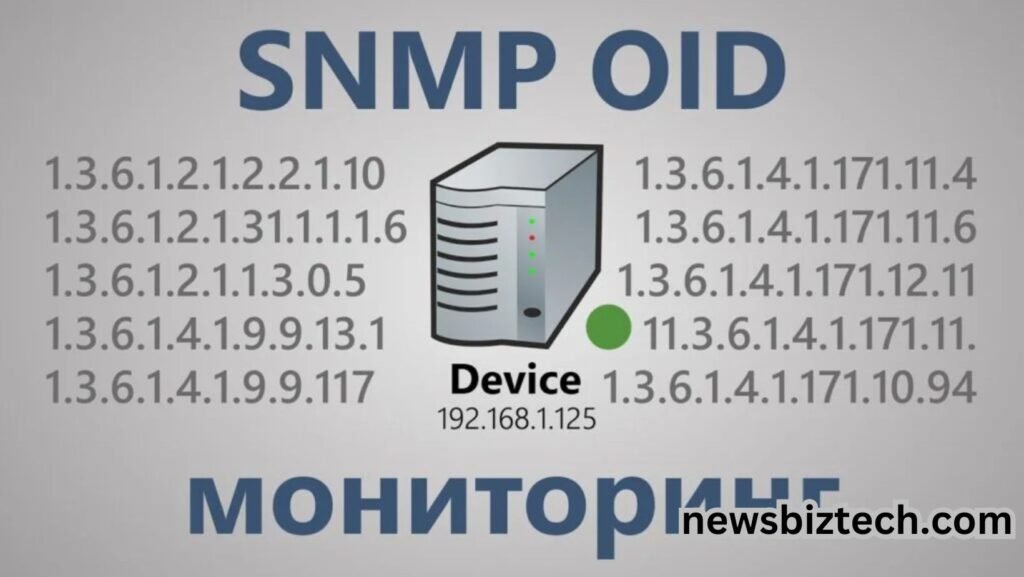Network monitoring and management depend critically on the Alpha Technologies FXM350 SNMP OID. Designed to offer strong network monitoring capabilities, the FXM350 is a hardware platform whose integration with Simple Network Management Protocol (SNMP lets managers effectively manage, monitor, and maximize network performance). A key instrument for network managers since the Object Identifiers (OID) connected with the FXM350 enable systems to get important data about many network devices and services. This paper investigates the specifics of the FXM350 SNMP OID, including its structure, application, and how it improves network performance monitoring, thereby providing useful advice and troubleshooting pointers.
Key Takeaways
- What is Alpha Technologies FXM350 SNMP OID?: Understand the concept, purpose, and significance of the FXM350 SNMP OID.
- SNMP Protocol Overview: Learn about the Simple Network Management Protocol (SNMP) and its relevance to network monitoring.
- FXM350 Hardware and Software: Explore the features, capabilities, and specifications of the Alpha Technologies FXM350 system.
- OID Structure: Understand how Object Identifiers (OIDs) work and their importance in SNMP-based network management.
- Real-World Use Cases: Learn how the FXM350 SNMP OID can be integrated into your network infrastructure for monitoring and management.
- Common Issues and Troubleshooting: Gain insights into potential challenges and solutions for using the FXM350 SNMP OID effectively.
Alpha Technologies FXM350 SNMP OID
Powerful network management tool Alpha Technologies FXM350 tracks several facets of network performance and condition. For a variety of network-connected devices, it uses the SNMP protocol to provide remote management, status monitoring, and defect detection. The Object Identifier (OID), a special identification used to refer to particular pieces of information accessible from network devices, is a fundamental element of SNMP-based network monitoring.
FXM350 SNMP OID is the collection of Object Identifiers applied on the FXM350 platform to gather particular data points concerning the performance, health, and operational state of the devices inside the network. These OIDs let system managers search the device for real-time data, therefore enabling monitoring of important indicators including:
- Latency, throughput, and bandwidth use define network performance.
- Device health consists in CPU load, memory consumption, and temperature data.
- Online/offline status of linked services defines their service quality.
The FXM350 SNMP OID guarantees that important network data is easily available, therefore enabling faster diagnosis and resolution of possible problems including performance bottlenecks.
Also Learn More: alpha technologies fxm350 snmp oid

Knowing SNMP and Its Part in Network Management
Among the most often used networks management protocols available is the Simple Network Management Protocol (SNMP). By letting managers search network devices for performance statistics, configuration settings, and defect information, it helps to monitor them.
Important aspects of SNMP:
- SNMP lets managers monitor a lot of devices from one console, therefore facilitating centralized network management.
- SNMP is scalable, hence it can manage networks of different sizes—from small local networks to massive corporate infrastructures.
- SNMP lets network managers get real-time updates regarding device health and network performance.
- SNMP helps managers to be aware of problems such device failures or unusual network behavior, so enabling quick troubleshooting.
Offering OID-based monitoring to directly access device and network status data straight from the hardware, the FXM350 combines SNMP capability to make this process even more efficient.
SNMP Design: Essential Elements
| Component | Function |
|---|---|
| Managed Devices | These are the network devices (routers, switches, servers) that need to be monitored. |
| SNMP Agent | A software component running on a managed device that gathers and reports information about the device. |
| SNMP Manager | The network management system that communicates with SNMP agents to collect and analyze data. |
| Management Information Base (MIB) | A virtual database that holds information about the device’s configuration, status, and performance. |
| OID (Object Identifier) | A unique identifier in a MIB used to reference specific pieces of data, such as device health or network performance metrics. |
This architecture depends critically on the OID since it directly points the data points the SNMP Manager can search from the controlled devices, including the FXM350.
Also Learn More: alpha technologies fxm350 snmp oid
Features and Capabilities of Alpha Technologies FXM350
Alpha Technologies’ FXM350 is perfect for network managers trying to simplify administrative chores since it is intended to provide great monitoring powers. Among the FXM350’s salient qualities and conveniences are:

Whole Network Surveillance
The FXM350 tracks a broad spectrum of network metrics including SNMP monitoring therefore enabling managers to:
- Device performance and state.
- Real-time performance metrics covering bandwidth use, delay, and packet loss.
- Network hardware’s power and temperature states.
Enhanced Availability
The FXM350 is built for high availability, so it can run constantly without failing, thereby guaranteeing network stability. For business settings needing 24/7 uptime for their network operations, this function is absolutely essential.
Modifiable Alerts
When particular thresholds are exceeded, say when device performance falls below a pre-defined limit, the FXM350 can be set to generate SNMP traps or email warnings. By means of proactive monitoring, problems are found before they become major ones.
Scalability
The FXM350 is quite expandable with support for several SNMP-enabled devices, which qualifies for networks of any size—from small businesses to big corporations.
Security Attributes
To guarantee that private network data is kept safe, the FXM350 combines multiple security techniques including SNMPv3 for safe communication between the devices and SNMP managers.
OIDs’s Place in Network Monitoring
An Object Identity (OID) in SNMP is a string of integers used to specifically identify managed objects on a network. Every object or piece of data found in the Management Information Base (MIB) of a network device has an OID assigned specifically. The OID structure is hierarchical; every number indicates a particular level in the management tree.
- The OID tree’s root.
- Points out a specific vendor—alpha technologies in this example.
- Pointing to the FXM350’s temperature sensor.
By requesting the appropriate OID, this hierarchical system makes it simple to get particular data—such as CPU use, power consumption, or network status. Frequent OIDs in the FXM350An SNMP manager can search each of these OIDs to access particular information on the running state of the FXM350 device.
Real-World FXM350 SNMP OID Applications
| OID | Description | Data Type |
|---|---|---|
| 1.3.6.1.4.1.250.100.1 | CPU Load | Integer |
| 1.3.6.1.4.1.250.100.2 | Memory Usage | Integer |
| 1.3.6.1.4.1.250.100.3 | Temperature | Gauge |
| 1.3.6.1.4.1.250.100.4 | Network Throughput | Counter |
| 1.3.6.1.4.1.250.100.5 | Power Supply Status | Integer |
Real-World Use Cases of FXM350 SNMP OID
In many real-world situations, especially for big companies mostly dependent on network infrastructure for business operations, the FXM350 SNMP OID is rather helpful. Here are some typical applications:

Monitoring Network Performance proactively
Regularly searching OIDs connected to bandwidth utilization and latency helps network managers make sure the system runs as it should and respond before performance problems start.
Monitoring Device Health
Monitoring temperature, power supply status, and CPU load using OIDs enables managers to make sure important hardware devices stay in excellent condition, therefore lowering the equipment failure risk.
Remote Problemshooting
By means of SNMP-enabled OIDs, network managers can remotely identify and fix network problems, therefore saving time and resources.
Also Learn More: alpha technologies fxm350 snmp oid
Typical problems with the FXM350 SNMP OID and troubleshooting
Although the FXM350 SNMP OID is a great tool for network control, managers may run across certain typical problems:
False OID Questions
Should the OID be mistyped or queried incorrectly, the SNMP manager may provide erroneous or none at all data. Administrators should make sure they are applying the proper OIDs as stated by the MIB of the FXM350.
Latency of Networks
Large networks with many devices could show SNMP query latency, particularly when concurrently polling data from several devices. By maximizing the polling frequency, managers can help to offset this.
SNMP Issues Regarding Security
Older SNMP versions—such as SNMPv1 or SNMPv2—are not encrypted, so they are easily attacked. Wherever feasible, SNMPv3 should be utilized to improve security.
- Before searching, always check OID syntax.
- Safe communications with SNMPv3.
- Change the polling frequency to help to avoid network congestion.
FAQs

Why is the FXM350 used?
Network monitoring with the FXM350 provides information on device performance, health, and network data. It facilitates managers of vast network systems.
Describe SNMP and explain why network management could benefit from it.
Monitoring and controlling network devices is accomplished with SNMP via protocol. It lets managers access performance statistics and send orders to network devices to improve network management.
What are OIDs, and how might the FXM350 relate to them?
In SNMP, object identifiers (OIDs) are distinct markers for data points. Using particular OIDs, the FXM350 gathers data on device status, performance, and other criteria.
How might I solve FXM350 SNMP OID problems?
Review OID syntax, make sure SNMPv3 is utilized for secure communication, and change polling frequencies to best serve network performance.
Conclusion
Network managers trying to maximize network performance and dependability will find the Alpha Technologies FXM350 SNMP OID to be absolutely essential. The FXM350 helps to effectively monitor network devices by using SNMP, OID-based monitoring, and real-time data retrieval, therefore facilitating the identification of possible problems before they impact the network. Tools like the FXM350 will remain indispensable for guaranteeing dependable operations as network infrastructues expand and becoming more sophisticated.

